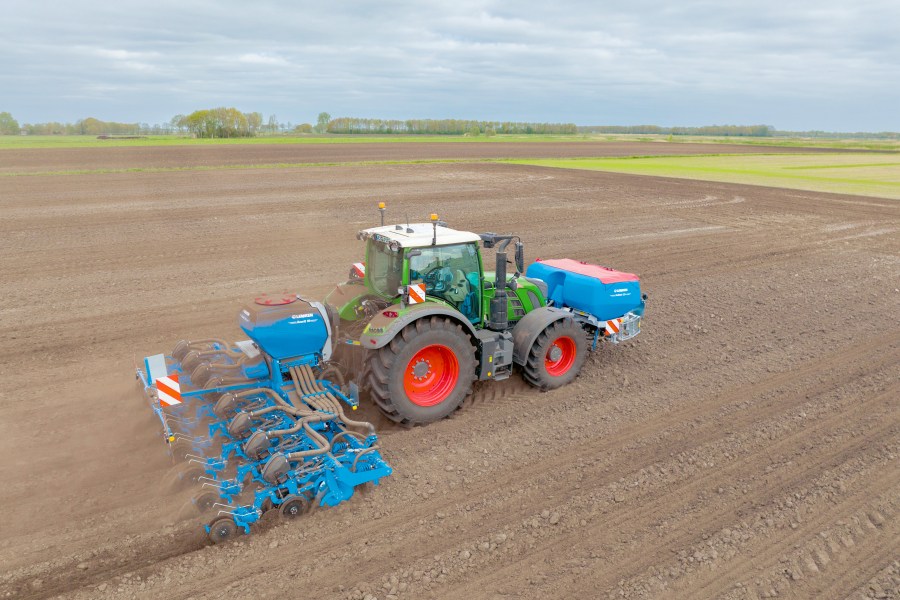Sowing seed in a triangular pattern – how and why? Lemken’s Paul Creasy says by redefining precision sowing in this way, crops can better utilise their resources.
“In particular, on sites at risk of erosion, this method offers a clear advantage compared with single rows due to more intensive rooting of the soil and improved plant spacing. In fact, work has shown that additional yields of up to 8% can be achieved.”
And once a crop is ready to harvest, conventional machines can still be used, he adds.
DeltaRow concept
This technology, as demonstrated through Lemken’s DeltaRow concept, is at the heart of the firm’s Azurit 10 which is available as an eight-row precision planter.
The DeltaRow consists of two partial rows that are offset from each other at a distance of 12.5cm. The synchronisation of these partial rows ensures exact placement in a triangular formation.
“Compared with a single row, the DeltaRow offers a 70% space advantage and therefore more water, nutrients and light for each plant. The fertiliser is placed within the DeltaRow in the root zone,” explains Paul.
Step-by-step
As sowing sets the course for a successful harvest, the tool sequence of the Azurit 10 plays a key role in precision sowing, he says. In the first work step, clearing stars remove stones, clods and harvest residues from the seed furrow. These can be adjusted in height using a perforated grid or removed completely if required.
Once the seed furrow has been cleared, mineral or liquid fertiliser is placed centrally underneath the DeltaRow using a fertiliser coulter – the closer the row spacing, the greater the advantage.
“For example, the Azurit supplies 16 partial rows of maize with eight rows of fertiliser – less fertiliser can therefore be used more effectively,” says Paul.
Trapeze packer segment
The fertiliser coulters place their bands to a maximum depth of 15cm, which should be reconsolidated before the next working step. On the Azurit 10, this is done by a trapeze packer segment. In front of the seed coulters, it not only ensures the pre-consolidation of both part rows, but also reliably closes the furrow above the fertiliser band.
Paul says this ensures capillary water ascent and therefore rapid and even emergence of the plants. “This works well in practice and can be clearly recognised by the central wedge of soil between the two partial rows,” he adds.
During subsequent sowing, a solid rubber depth control roller between the two coulters bears the weight of the sowing unit. Two double disc coulters then place the seed precisely on the reconsolidated seed horizon in the DeltaRow formation.
“Even at high working speeds, the Azurit 10 delivers outstanding singulation quality. This is made possible by the low peripheral speeds of the singulation discs,” says Paul.
Seed discs
Two offset perforated discs separate the seed – the fixed connection between the two seed discs guarantees synchronisation within the DeltaRow.
Furthermore, each singling unit is driven by a separate electric motor, storing only a small amount of seed. Paul explains that seed replenishment is sensor-controlled and automatic from the central hopper. “An auger metering system feeds the seed from there into the air flow and then to the singling units.”
The seed is conveyed from the singling unit via a shot channel to the seed groove by the existing overpressure with the seed groove formed by double disc coulters.
Fixed position
“The outer disc of the double disc coulters is set at an angle, while the inner disc runs straight along the soil wedge of the trapeze packer roller. Between the disc coulters, the shooting channel ends in front of a catcher roller, which presses the seeds down and prevents them from rolling in the furrow. The seed is fixed exactly at the desired position on the seed horizon,” says Paul.
Seed embedding is completed with the ground cover. “Different types of levellers ensure the seed is covered with soil and pressed down. If, for example, pressure rollers are used, these press vertically onto the seed row. This space advantage for the plant means that a higher yield can be achieved with the same crop density,” concludes Paul.




